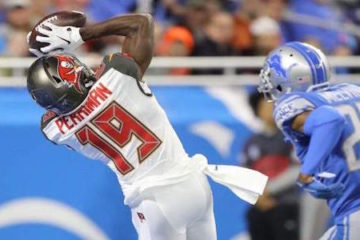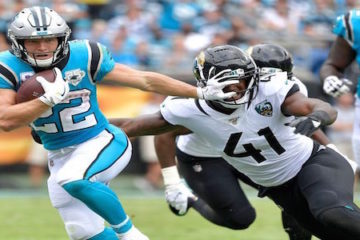2012 Fantasy Football: Auction Draft Strategy
I read two auction draft strategy articles recently. One was great and full of useful information (check it out here with a hat tip to @davidgonos). The other was cliché and fairly useless. But those articles reminded me that I should share my auction methodology since I have a forum to do so. It may not be for everyone, but I imagine there are some of you who will find it useful.
Basically, you should try to treat an auction draft as you would a snake draft by trying to acquire one player that would go in each round of a snake draft. For example, in a ten-team league, you want to draft one guy going 1-10, another going 11-20, and so on.
The chart above is a tool that should help you budget your money to be able to do that. The number represented for each round is the average number of dollars a fantasy owner should spend each “round.” Again, for example, in a ten-team league, the ten owners should spend around $530 on the top ten players that would have gone off the board in a snake draft (which is over ¼ of all the money spent in the draft).
As you go along, you simply adjust your values depending on what you end up with. If you spent big on one of the top three running backs in a ten-team league, it would cost you $60 or more. Say you spent $61 on the man with four capital letters in his name, LeSean McCoy, in the first round (which is his average draft value on ESPN.com). That would put you $8 over the budget laid out above. That means you’d need to spend less than average on your next couple of picks so that you don’t shoot your wad too early. Spend $34 and $22 on your next two picks and you’re right back on track.
Obviously players won’t be nominated in order. You could have a 5th round quality player nominated third. Or an 11th round quality player nominated in the 30-40 range. If that happens and you see some value and end up acquiring the player, just slot them into the round with the price closest to what you paid for the player. For example, if you end with a $10 player right off the bat, simply slot him in as your “7th round pick” and knock a buck off what you expected to spend in one of the other rounds.
Don’t freak out if everyone is going way over value at first. Try to find a guy or two going for full price and pay it, so you don’t end up left with extra money at the end of the draft, but don’t go more than a buck or two over value for anyone. If everyone wastes money up top, you’ll be sitting pretty in the middle rounds. Maybe you can’t find any value on a second or third round quality player, but saving that money might allow you to grab six 4th-7th round quality guys instead of four. Top end talent is important, but as long as you don’t miss out on it completely, spending your extra money in the middle rounds will leave you with one of deepest teams, if not the deepest team, in the league.
I hope all of this makes sense. I’ve been using it for several years now, and it has served me well. But I found this somewhat difficult to explain precisely. Ultimately, I think it’s best if you mock using this system and find the best way to make it work for you as you move through a draft. But I hope that this can provide a budgetary framework for you to responsibly build a solid, balanced team in an auction draft.
Written by Brett Talley exclusively for thefantasyfix.com. Brett is a soon-to-be attorney in Dallas who wishes he was better at budgeting money in the real world. If you have any further questions about this particular topic, feel free to ask him on Twitter (@TheRealTAL) or email him at brett@thefantasyfix.com. If he didn’t explain it well enough above, he’d be happy to try the explanation again via email.
Basically, you should try to treat an auction draft as you would a snake draft by trying to acquire one player that would go in each round of a snake draft. For example, in a ten-team league, you want to draft one guy going 1-10, another going 11-20, and so on.
The chart above is a tool that should help you budget your money to be able to do that. The number represented for each round is the average number of dollars a fantasy owner should spend each “round.” Again, for example, in a ten-team league, the ten owners should spend around $530 on the top ten players that would have gone off the board in a snake draft (which is over ¼ of all the money spent in the draft).
As you go along, you simply adjust your values depending on what you end up with. If you spent big on one of the top three running backs in a ten-team league, it would cost you $60 or more. Say you spent $61 on the man with four capital letters in his name, LeSean McCoy, in the first round (which is his average draft value on ESPN.com). That would put you $8 over the budget laid out above. That means you’d need to spend less than average on your next couple of picks so that you don’t shoot your wad too early. Spend $34 and $22 on your next two picks and you’re right back on track.
Obviously players won’t be nominated in order. You could have a 5th round quality player nominated third. Or an 11th round quality player nominated in the 30-40 range. If that happens and you see some value and end up acquiring the player, just slot them into the round with the price closest to what you paid for the player. For example, if you end with a $10 player right off the bat, simply slot him in as your “7th round pick” and knock a buck off what you expected to spend in one of the other rounds.
Don’t freak out if everyone is going way over value at first. Try to find a guy or two going for full price and pay it, so you don’t end up left with extra money at the end of the draft, but don’t go more than a buck or two over value for anyone. If everyone wastes money up top, you’ll be sitting pretty in the middle rounds. Maybe you can’t find any value on a second or third round quality player, but saving that money might allow you to grab six 4th-7th round quality guys instead of four. Top end talent is important, but as long as you don’t miss out on it completely, spending your extra money in the middle rounds will leave you with one of deepest teams, if not the deepest team, in the league.
I hope all of this makes sense. I’ve been using it for several years now, and it has served me well. But I found this somewhat difficult to explain precisely. Ultimately, I think it’s best if you mock using this system and find the best way to make it work for you as you move through a draft. But I hope that this can provide a budgetary framework for you to responsibly build a solid, balanced team in an auction draft.
Written by Brett Talley exclusively for thefantasyfix.com. Brett is a soon-to-be attorney in Dallas who wishes he was better at budgeting money in the real world. If you have any further questions about this particular topic, feel free to ask him on Twitter (@TheRealTAL) or email him at brett@thefantasyfix.com. If he didn’t explain it well enough above, he’d be happy to try the explanation again via email.







